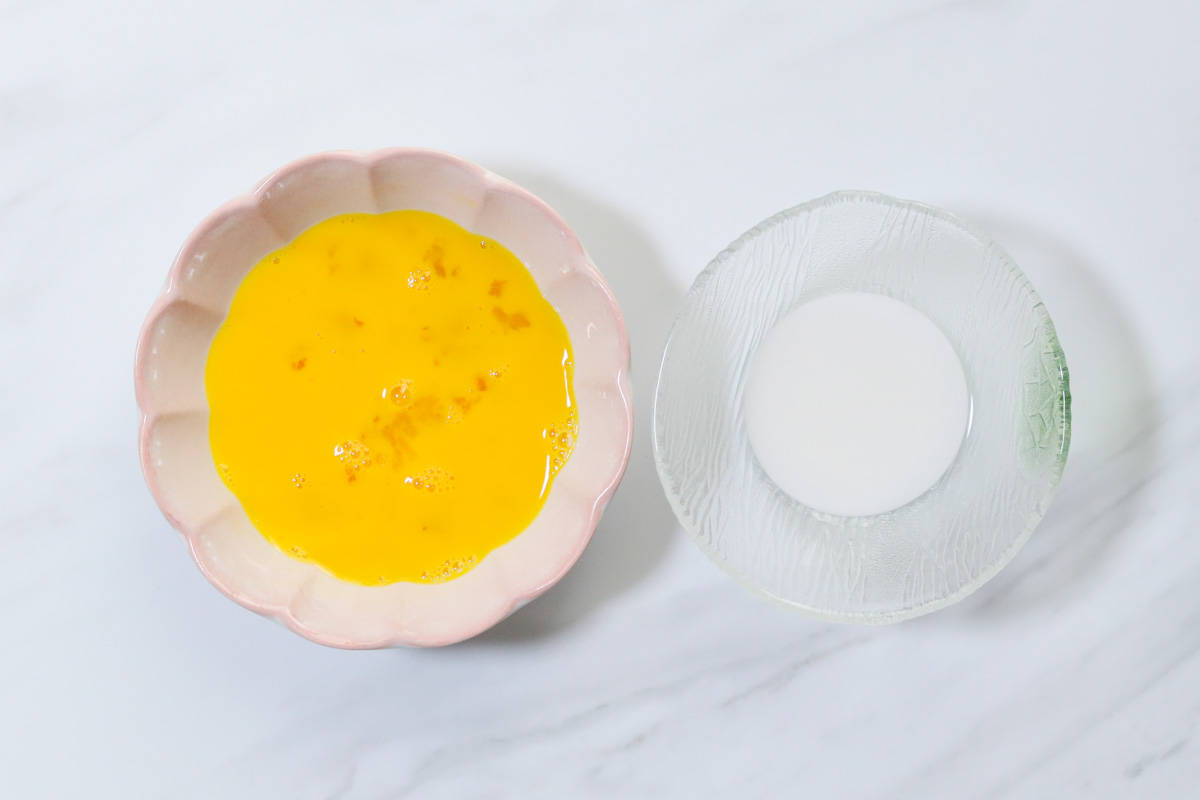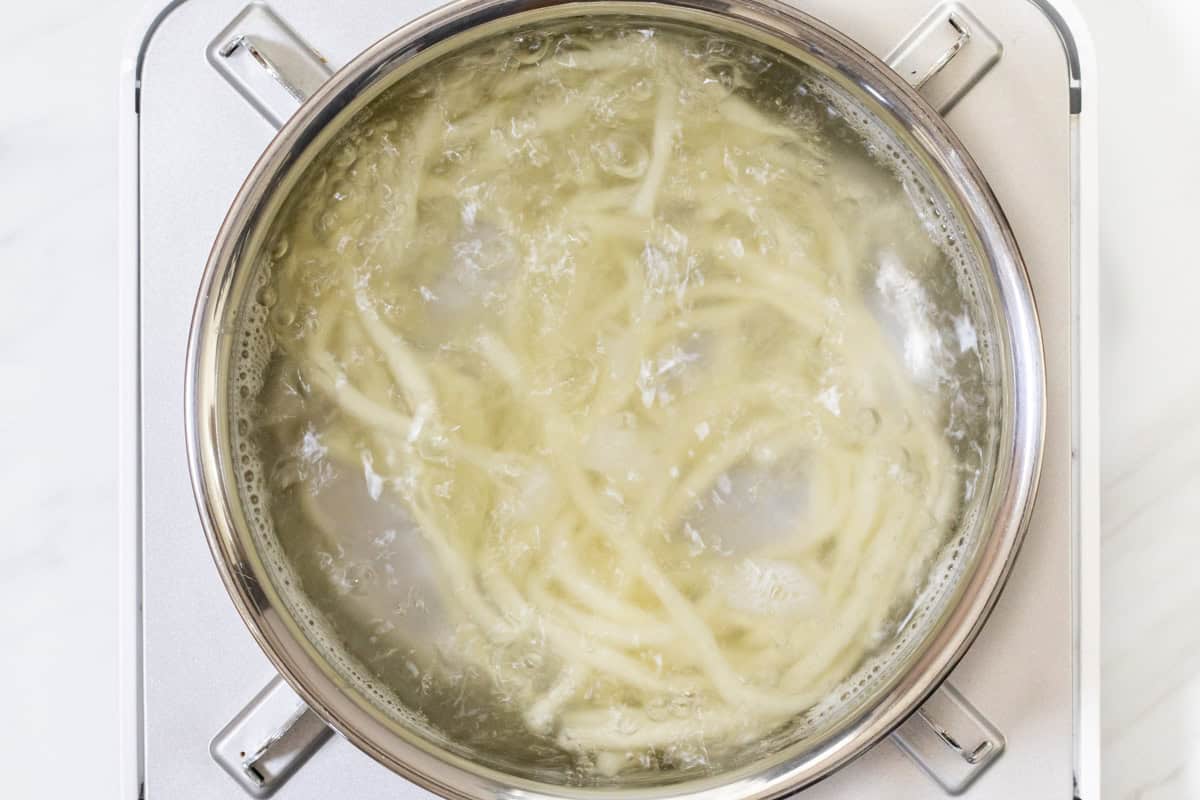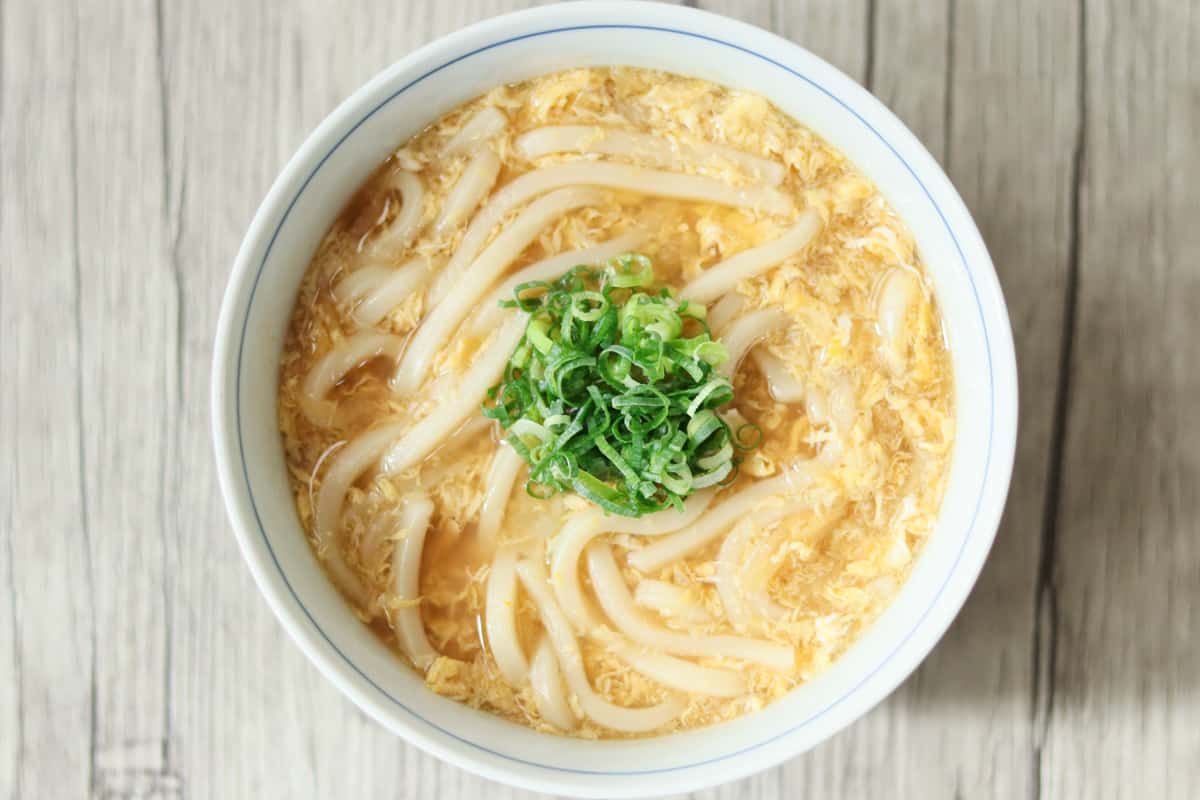Tamago-Toji Udon is a classic Japanese udon noodle soup that is easy to prepare with eggs. The fluffy eggs and thick, flavorful dashi broth complement each other, while the subtle aroma of ginger adds a delightful touch.

Jump to:
What is Tamago-Toji Udon?
Tamago-Toji Udon is a traditional Japanese udon noodle soup made by pouring beaten eggs into dashi broth seasoned with ginger and other Japanese seasonings. It is often thickened with starch. "Tamago" means egg, and "Toji" refers to the technique of binding ingredients together. By adding beaten eggs at the end of the cooking process, you can enjoy the fluffy texture of the eggs as they blend into the soup.
The combination of dashi and eggs is surprisingly harmonious, and this pairing also appears in various Japanese dishes, such as Chawanmushi (savory egg custard), Dashimaki Tamago (rolled omelet with dashi), and Kakitamajiru (Japanese egg drop soup). Once you try it, you will be captivated by its comforting flavor—so be sure to give it a try.

The comforting qualities
This dish has a slightly different character compared to regular udon noodle soups—it is especially popular on cold days or when you are feeling under the weather. The reason is that it is packed with nutrients and contains ingredients that help warm the body.
These qualities mainly come from the following ingredients:
- Eggs: Rich in protein, vitamins, and minerals, and easy to digest.
- Ginger: Known for its warming and digestive benefits. While udon noodles and eggs are already gentle on the stomach, adding ginger makes the dish even easier to digest, especially when you don’t have much of an appetite.
- Starch: It thickens the soup and helps the dish retain heat longer than regular udon soups.
The combination of the thickened soup, fluffy eggs, and subtle aroma of ginger not only warms you from the inside out, but also provides a comforting feeling. This is why this dish has long been cherished as a meal that nourishes the body. Of course, it is just as perfect for an everyday meal.
Optional additions
The main ingredients in this dish are beaten eggs and ginger, but you can also add other ingredients. Common additions include kamaboko (fish cake), shiitake mushrooms, enoki mushrooms, aburaage (fried tofu pouches), and chicken. You can also use any other ingredients you have on hand.
However, keep in mind that this dish is meant to highlight the flavors of the dashi broth and eggs, so it is best to use only a small amount of additional ingredients, or none at all. Keeping it simple and avoiding too many extras will result in a better flavor.
The balance of dashi and egg
Udon noodle soup generally tastes best when you make the dashi broth richer than you would for most other Japanese dishes. This is because the noodles themselves have a relatively mild flavor, so the flavor of the broth really stands out. In many of the udon recipes I share on my blog, I make the broth slightly stronger.
However, this tradition doesn’t apply to tamago-toji udon. Its appeal lies in the delicate balance between the dashi and the egg. In other words, for this recipe, I recommend using a regular dashi—the kind typically used for miso soup or other everyday dishes.

📋Step-by-step recipe
Ingredients
- 1 serving udon noodles (fresh, dried, pre-cooked, or frozen)
- 0.2 oz ginger
- 1 green onion / scallion
- 1 large egg (about 2.1 oz/60 g, including shell)
- ½ Tbsp potato starch or corn starch
- ½ Tbsp water (for the starch)
Bonito dashi:
- 1 ½ cups water
- ⅓ cup bonito flakes (katsuobushi)
Seasonings:
- ½ Tbsp mirin
- ¼ tsp salt
- 1 Tbsp light soy sauce (You can substitute it with regular soy sauce; the main difference is the color.)
Instructions
🕒 Total: 25 minsIf you already have bonito dashi or another type of dashi, start from step 3. In that case, use 1 ¼ cups (300 ml) of your dashi per serving.

Step 1
Put water in a pot and bring it to a boil. Once boiling, reduce the heat to low, add bonito flakes, and let it simmer for 3 minutes.

Step 2
Turn off the heat and strain the mixture through a sieve lined with paper towels or a cloth (such as cheesecloth). Alternatively, if you don't mind a few fine bonito flakes remaining, you can simply use a fine-mesh strainer. Bonito dashi is now ready.

Step 3
Peel the ginger and cut it into thin strips. Thinly slice the green onion.

Step 4
Crack the egg into a small bowl and beat it. In another small bowl, mix the starch with water until smooth.

Step 5
Return the dashi to the pot, add the shredded ginger and seasonings (mirin, salt, and light soy sauce), and bring it back to a boil. Once boiling, gradually add the dissolved starch while stirring constantly to thicken it and avoid lumps. Continue simmering for about 20 seconds to eliminate any powdery taste.

Step 6
Gradually drizzle the beaten egg into the pot, distributing it evenly. Once the egg has set, gently stir it, then turn off the heat.

Step 7
If using fresh, dried, or pre-cooked udon noodles: Boil the udon noodles in a separate pot according to the package instructions. Once cooked, drain them in a colander.
If using frozen udon noodles: Lightly sprinkle water over the udon noodles. Then, place them on a microwave-safe plate, cover with plastic wrap or a microwave-safe lid, and microwave on medium power (500-600W) for 3.5 to 4 minutes, or until heated through. (Since this method can cause uneven heating, it is best to microwave one serving at a time. You can also boil them like the other types of udon noodles.)

Step 8
Place the noodles in a bowl and pour the soup over them. Loosen the noodles with chopsticks, then top with green onions.
To store
This dish is not suitable for storage because cooked udon noodles tend to lose their texture over time, making them less enjoyable. However, the udon soup itself can be stored for up to 2 days.
Cooking tips
- The beaten egg should be drizzled gradually and evenly into the pot. This helps prevent the egg from clumping and creates a light, fluffy texture.
- After drizzling the beaten egg into the pot, make sure it sets before stirring. Stirring before the egg is fully set can make the udon soup cloudy.

If you try this recipe, I’d love to hear what you think. Please consider leaving a review and star rating in the comments below. If you enjoyed it, I’d really appreciate it if you shared it with your friends.
More udon noodle recipes you'll love
Recipe card

Tamago-Toji Udon (Egg Drop Udon Noodle Soup)
Ingredients
- 1 serving udon noodles (fresh, dried, pre-cooked, or frozen)
- 0.2 oz ginger
- 1 green onion / scallion
- 1 large egg (about 2.1 oz/60 g, including shell)
- ½ Tbsp potato starch or corn starch
- ½ Tbsp water (for the starch)
Bonito dashi:
- 1 ½ cups water
- ⅓ cup bonito flakes (katsuobushi)
Seasonings:
- ½ Tbsp mirin
- ¼ tsp salt
- 1 Tbsp light soy sauce (You can substitute it with regular soy sauce; the main difference is the color.)
Instructions
- Put water in a pot and bring it to a boil. Once boiling, reduce the heat to low, add bonito flakes, and let it simmer for 3 minutes.
- Turn off the heat and strain the mixture through a sieve lined with paper towels or a cloth (such as cheesecloth). Alternatively, if you don't mind a few fine bonito flakes remaining, you can simply use a fine-mesh strainer. Bonito dashi is now ready.
- Peel the ginger and cut it into thin strips. Thinly slice the green onion.
- Crack the egg into a small bowl and beat it. In another small bowl, mix the starch with water until smooth.
- Return the dashi to the pot, add the shredded ginger and seasonings (mirin, salt, and light soy sauce), and bring it back to a boil. Once boiling, gradually add the dissolved starch while stirring constantly to thicken it and avoid lumps. Continue simmering for about 20 seconds to eliminate any powdery taste.
- Gradually drizzle the beaten egg into the pot, distributing it evenly. Once the egg has set, gently stir it, then turn off the heat.
- If using fresh, dried, or pre-cooked udon noodles: Boil the udon noodles in a separate pot according to the package instructions. Once cooked, drain them in a colander.If using frozen udon noodles: Lightly sprinkle water over the udon noodles. Then, place them on a microwave-safe plate, cover with plastic wrap or a microwave-safe lid, and microwave on medium power (500-600W) for 3.5 to 4 minutes, or until heated through. (Since this method can cause uneven heating, it is best to microwave one serving at a time. You can also boil them like the other types of udon noodles.)
- Place the noodles in a bowl and pour the soup over them. Loosen the noodles with chopsticks, then top with green onions.
Notes
- If you already have bonito dashi or another type of dashi, start from step 3. In that case, use 1 ¼ cups (300 ml) of your dashi per serving.
- This dish is not suitable for storage because cooked udon noodles tend to lose their texture over time, making them less enjoyable. However, the udon soup itself can be stored for up to 2 days.













Leave a Rating and a Comment